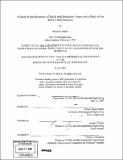A study of the dynamics of shells with boundary layers and a study of the MITC3 shell element
Author(s)
Malek, Samar R. (Samar Rula)
DownloadFull printable version (6.714Mb)
Alternative title
Study of the MITC3 shell element
Other Contributors
Massachusetts Institute of Technology. Dept. of Civil and Environmental Engineering.
Advisor
Klaus-Jürgen Bathe.
Terms of use
Metadata
Show full item recordAbstract
Shell structures are frequently used for their aesthetic appeal, and material efficiency. They can be found everywhere, in all sorts of contexts. For example, they can serve as roofs to encapsulate large areas (think Millennium Park in Chicago); as fuselage for an airplane; as the frame of a car; as chemical containers (such as pressure vessels); even submarines. One of the most challenging phenomena in shells is boundary layers. Boundary layers are high concentrations of energy due to either irregular loadings, or incompatible boundary conditions, or geometric discontinuities. Previous studies have determined the location of this concentrated energy and how that location varies depending on the thickness of the shell; up to now however, any correlation between the boundary layers and the vibrations of the shell has not yet been examined. In our first study, we review the boundary layer behavior, and we investigate the dependence of the shell's natural frequencies on the boundary layer phenomenon for two shell benchmark problems: the Scordelis-Lo Roof and the Clamped Hyperboloid. (cont.) In our second study, we shortly review the MITC3 shell element. This element is known to lock in plate bending cases for a specific mesh pattern. Finally, we formulate a new MITC triangular, four node element and investigate its plate bending behavior in detail. Our results show that including an extra node in the center of the element does not improve the plate bending behavior. We discuss our results and make suggestions for future investigations.
Description
Thesis (S.M.)--Massachusetts Institute of Technology, Dept. of Civil and Environmental Engineering, 2007. Includes bibliographical references (leaf 63).
Date issued
2007Department
Massachusetts Institute of Technology. Department of Civil and Environmental EngineeringPublisher
Massachusetts Institute of Technology
Keywords
Civil and Environmental Engineering.